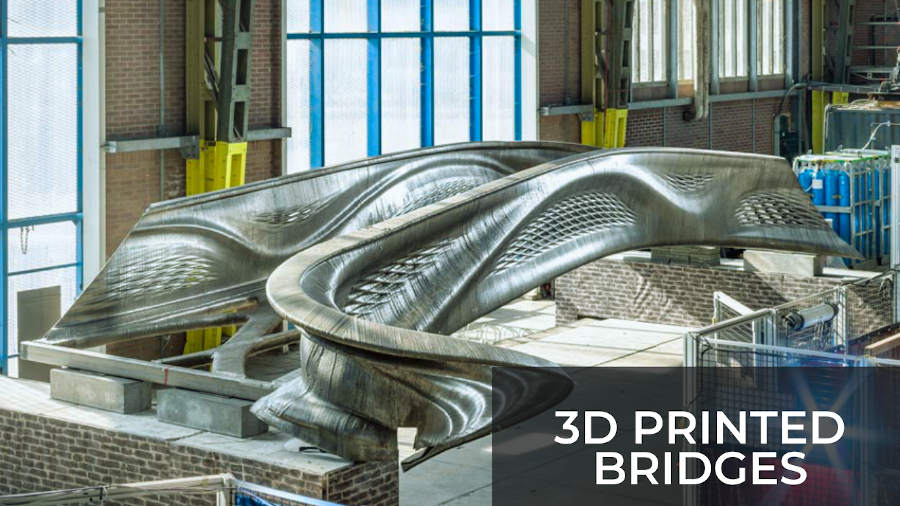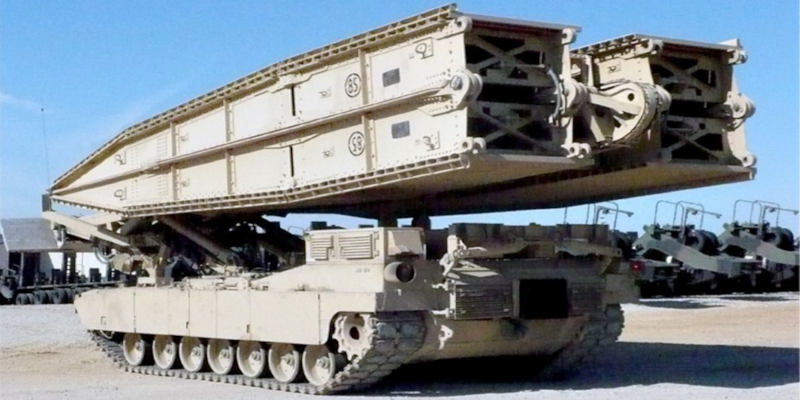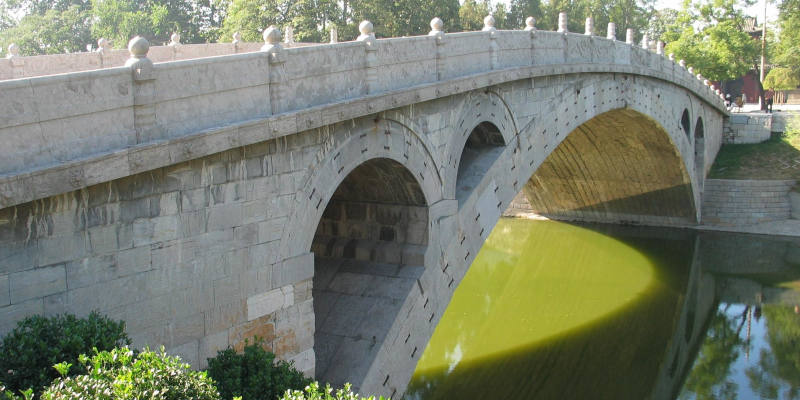
3 Amazing 3D Printed Bridges Changing How We Build


At 3DSourced we’ve covered everything 3D printing and 3D since 2017. Our team has interviewed the most innovative 3D printing experts, tested and reviewed more than 20 of the most popular 3D printers and 3D scanners to give our honest recommendations, and written more than 500 3D printing guides over the last 5 years.
Industrial 3D printers, modified robots, and new techniques have gradually allowed us to 3D print bigger and bigger objects. So, with that in mind, just how close are we to being able to produce 3D printed bridges?
3D printing bridges offers many benefits. They can be built faster, with less material and workers. And as a common piece of infrastructure, these benefits could save massive amounts of time and money.
These benefits have also led to concepts that may seem like something out of science-fiction. Imagine 3D printing robots that can approach an obstacle, scan it, generate a bridge design, and then print it.
But not only does it print the bridge independently, but it also moves across the bridge whilst printing it, essentially printing in mid-air to avoid the use of heavy lifting machinery.

Well, many companies are indeed pursuing this concept.
However, currently very few 3D printed bridges have actually made it to production and operation. But that doesn’t mean that exciting 3D printed bridge projects are in short supply.
So, with that in mind, here are the most exciting 3D printed bridges.
MX3D: The World’s First 3D Printed Bridge?
In 2015, 3D printing company MX3D unveiled their idea for what could be the world’s first professionally 3D printed pedestrian bridge.
From 2015, the bridge’s design would undergo constant development. It wouldn’t be constructed until 2017, and only finished its final phase of testing in 2019.
Soon afterwards MX3D got permission to install their bridge across a canal in Amsterdam’s red-light district. Despite hoping to do just that by late 2019, renovations to the canal’s wall have halted their plans. The bridge has seen some use since, being on display for the 2018 Dutch Design Awards in Eindhoven, but unfortunately it remains uninstalled.

Despite often being reported as the world’s first 3D printed bridge, this delay threatens MX3D’s claim to that title.
The title was always somewhat undermined by the fact that world’s first “3D printed cyclist bridge,” and “3D printed concrete bridge,” were both opened in 2017.
Because of this, many outlets referred to MX3D’s bridge as “the world’s first 3D printed stainless-steel bridge,” instead. But this title too is under threat, with the delay meaning that another company may still install their bridge first.
Not Just a Bridge, but a Smart One Too
Regardless, many of the techniques MX3D used were trailblazing. It furthered the industry’s understanding of how to 3D print steel, and its techniques were adopted by following 3D printed bridge builders.
During an interview in 2016, Joris Laarman, the company’s co-founder, stated that
“The bridge is very much a learning process for us. “We are trying to test all the facets of the technology, to develop the software, and the right type of metal that is good for printing… In the end, this will result in a really big library of algorithms and scripts that in the future we can use for all kinds of geometries.”
To this end, a smart sensor network has been attached to the bridge. These sensors give real-time structural measurements, such as strain, displacement, and vibration.
Additionally, they allowed MX3D to construct a “digital twin” of the bridge.
“The data from the sensors will be input into a ‘digital twin’ of the bridge, a living computer model that will reflect the physical bridge with growing accuracy in real time as the data comes in. The performance and behaviour of the physical bridge can be tested against its digital twin, which will provide valuable insights to inform designs for future 3D printed metallic structures.”

The bridge itself was constructed in 1-meter sized sections. MX3D used car assembly-line welding robots, modified them, and ran them on custom software.
These robots then 3D printed the bridge sections layer by layer, before then each section was finally assembled.
US Marine Corps: Military 3D Printed Bridges
Outside of the civilian sector, 3D printing is also being experimented with by the US Marine Corps.
Currently, the Marine Corp and most international military engineers have the capability to rapidly install bridges over obstacles. In combat operations, this can be done from armored vehicles that unfurl a bridge over an obstacle.
Some of these bridging vehicles can even simply drive into the obstacle to become the bridge, such as in the case of amphibious vehicles that become floating bridges over rivers.
These systems are highly effective, with some of the slowest to deploy still only taking a handful of soldiers under an hour to set up.

But this hasn’t stopped them from experimenting with 3D printing.
In 2019, Marines at Camp Pendleton California constructed a concrete 3D printed bridge.
The Camp Pendleton Bridge
The process begins with portable 3D scanners taking measurements of the obstacle or gap. This scan then generates a blueprint of the required bridge. Adjustments are made manually, then the design is sent to a giant 3D printer. The bridge was printed with a mixture of concrete and gravel, before being assembled in place.
Although these bridges are impressive, they won’t be replacing the military’s current options just yet. This system is not autonomous, and it requires a team of soldiers and heavy machinery to install.
However, this experiment was also not intended to replace bridging vehicles, it instead caught the military’s attention as a potentially replacement for conventionally built bridges.

This 3D printed bridge uses less materials, less soldiers, and is cheaper to build than a conventional one. Whilst being interviewed on the project, Captain Eric Satterthwaite stated that
“This whole bridge was less than $1,000. Replacement bridges than can span the same gap, that were used similarly in Afghanistan, cost upwards of $75,000… From a humanitarian standpoint, if we went in to do disaster relief and we needed a bridge that needed to stay for the locals to use, again, we could print the exact same design with fewer Marines and less materials.”
Outside of this prototype, there has been little presented in the way of 3D printed military bridges. However, projects such as this at least show us that there is an appetite for experimentation. So, as the technology improves, we may also see more 3D printed military bridges.
Shanghai “The World’s Longest 3D Printed Bridge”
On the 12th of January 2019, a 26.3-meter-long 3D printed concrete bridge was installed in Shanghai. Despite being unveiled with relatively minimal fanfare, it immediately became the longest 3D printed concrete bridge in the world.
The project was designed by a team from the Tsinghua University School of Architecture. Interestingly, rather than taking a modern form, the bridge’s design is ancient. nspired by the Anji, constructed 1,400 years ago, the Anji is currently the oldest standing bridge in China.

Similar to MX3D’s design, this bridge was also printed in sections. However, rather than being assembled in the factory these sections were instead assembled on-location. An assembly video shows cranes and heavy-lifting equipment slotting the individual concrete sections into place over a metal frame.
This design choice has raised some eyebrows. After all, can it truly be called a concrete bridge, when it has a metal frame hiding inside? That question is hard to answer, as it’s unclear just how much of the load the metal frame is bearing.
This bridge is also fitted with a digital monitoring system, allowing the designers to record how the bridge changes or deforms over time.

Unlike MX3D however, this bridge didn’t face any installation delays. The team stated that the 176 concrete sections were all printed within 450 hours. And soon after construction, the bridge was installed.
A Bridge Too Far?
These three projects all somewhat fall short of the concept we first introduced. None of them are autonomously built, they all require teams of workers and heavy machinery to install, and none of them can print in mid-air.
They’re also in no position to really threaten conventionally built bridges. After all, the longest 3D printed bridge is less than 30 meters long, and it’s not strong enough to reliably hold anything heavier than pedestrians.
However, these shortcomings don’t mean that the technology isn’t impressive. All three projects proved that 3D printed bridges can be built, and that they can be structurally sound. Additionally, our last two projects highlighted just how much cheaper and faster they are to build compared to conventionally ones.
Interest in 3D printed bridges only continues to grow, with projects continuing to appear. As recently as this year, another company is actively working towards beating Tsinghua University’s world record.
Simply called “The Bridge Project,” this bridge is being constructed by Dutch firm Bam & Webber Beamix. The bridge has been designed principally to highlight the eco-friendly nature of 3D printed construction, as well as to beat the existing record.
The bridge is set to be installed in Nijmegen, partly because the city was named the “Green capital of Europe” in 2018. But their plans don’t end there, with the company hoping to install four more bridges across the Netherlands!
With the interest and amount of 3D printed bridge project continuing to mount, it may not actually be all too long before they truly are building themselves in mid-air.
Other articles you may be interested in:



















